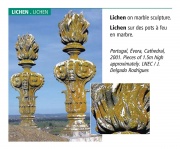Difference between revisions of "Lichen"
Jump to navigation
Jump to search
m (Text replace - "== Authority ==" to "== Sources Checked for Data in Record ==") |
|||
| Line 4: | Line 4: | ||
Any of about 18,000 thallophytic organisms composed of an algae and a fungus growing in a symbiotic relationship on a solid substrate, such as a rock. Lichen have been used since ancient times as a source of food, medicine and [[lichen dyes|dyes]]. Lichens grow relatively slowly (about 0.1 - 10 mm per year). Algae perform phtosynthesis producing carbohydrates and vitamins while the fungi absorb water vapour and provide a protective environment for the delicate algae. Their composite body is called a thallus and is classified as: | Any of about 18,000 thallophytic organisms composed of an algae and a fungus growing in a symbiotic relationship on a solid substrate, such as a rock. Lichen have been used since ancient times as a source of food, medicine and [[lichen dyes|dyes]]. Lichens grow relatively slowly (about 0.1 - 10 mm per year). Algae perform phtosynthesis producing carbohydrates and vitamins while the fungi absorb water vapour and provide a protective environment for the delicate algae. Their composite body is called a thallus and is classified as: | ||
| − | + | * squamulose: small, flat scales that do not adhere tightly to substrate | |
| + | * crustose: flat, firmly attached to substrate | ||
| + | * foliose: leaf-like lobes, attached in the center to substrate by clusters of hyphae (rhizones); may reach several feet in diameter | ||
| + | * fructicose: plant-like growth attached at one point or cluseter called a holdfast | ||
| − | + | == Resources and Citations == | |
| − | + | * ''Encyclopedia Britannica'', http://www.britannica.com Comment: "lichen" [Accessed April 26, 2002]. | |
| − | |||
| − | |||
| − | |||
| − | |||
| − | |||
| − | * ''Encyclopedia Britannica'', http://www.britannica.com Comment: "lichen" | ||
* G.Caneva, M.P.Nugari, O.Salvadori, ''Biology in the Conservation of Works of Art'', ICCROM, Rome, 1991 | * G.Caneva, M.P.Nugari, O.Salvadori, ''Biology in the Conservation of Works of Art'', ICCROM, Rome, 1991 | ||
Revision as of 09:16, 26 June 2020
Description
Any of about 18,000 thallophytic organisms composed of an algae and a fungus growing in a symbiotic relationship on a solid substrate, such as a rock. Lichen have been used since ancient times as a source of food, medicine and dyes. Lichens grow relatively slowly (about 0.1 - 10 mm per year). Algae perform phtosynthesis producing carbohydrates and vitamins while the fungi absorb water vapour and provide a protective environment for the delicate algae. Their composite body is called a thallus and is classified as:
- squamulose: small, flat scales that do not adhere tightly to substrate
- crustose: flat, firmly attached to substrate
- foliose: leaf-like lobes, attached in the center to substrate by clusters of hyphae (rhizones); may reach several feet in diameter
- fructicose: plant-like growth attached at one point or cluseter called a holdfast
Resources and Citations
- Encyclopedia Britannica, http://www.britannica.com Comment: "lichen" [Accessed April 26, 2002].
- G.Caneva, M.P.Nugari, O.Salvadori, Biology in the Conservation of Works of Art, ICCROM, Rome, 1991
